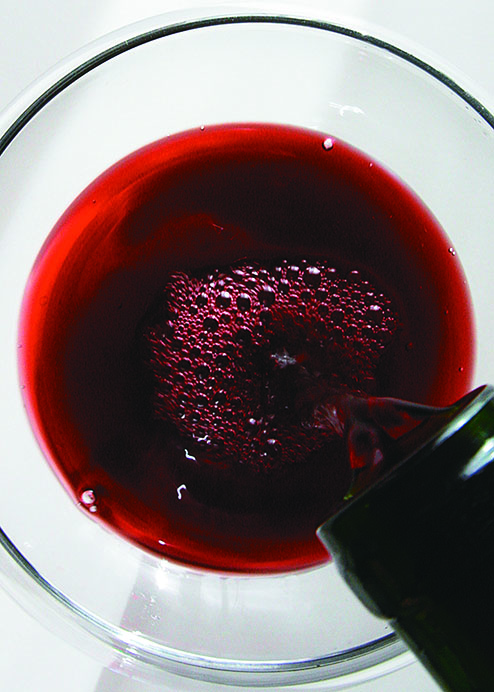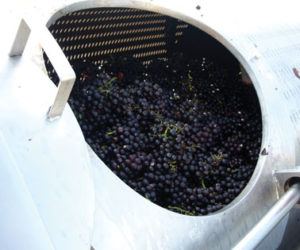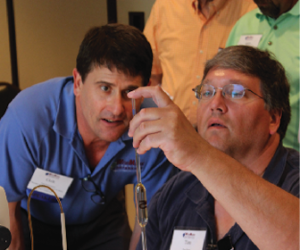
You might not achieve perfection on the first try, but it’s certain that changing up your game can make a huge difference to your finished kit wine. What kind of difference? You can make a difference so big that when you’re done it might seem like a completely different wine altogether. When you know the secret, you’ll be able to take a drinkable red and make it a hulking monster of intensity, a rolling, majestic wine that countenances only slow considered sips. Tannin additions are the key.
Kit wines are balanced to achieve drinkability as early as possible. Standard kits have an acceptable flavor profile in as little as two or three months and even the ultra-premium, single-vineyard, grapeskin-in kits are mostly drinkable in only a year, something unheard of in a flagship wine from a commercial winery, which might take three to five years to approach a drinkable state. One of the only ways to achieve this early drinkability is to trade it off by balancing the kits to low levels of tannin.
Because tannin additions are made post-fermentation to finished wine I was previously compelled to conceal and suppress the idea from kit winemakers. The primary goal of Technical Services at wine kit companies is to ensure that consumers can make a consistent, early-drinking wine, achieving the same results over and over again. While it’s common practice in the commercial wine tannin additions can be unpredictable, and kit companies feel that given the idiosyncratic nature of individual taste among their consumers the risk is too high that the changes wouldn’t be perceived as positive, or that they would have inconsistent (and thus discouraging) results.
It’s also true that there’s tannin and there’s tannin. Winemakers toss that word around pretty loosely, but there are tens of thousands of phenolic compounds under the umbrella term tannin. For a long time winemaking tannins available to home users came in only a single type, labelled “tannic acid,” which was intended as a fermentation additive to stabilize color and add structure. The problem with adding this sort of tannin to a kit wine was that it was so active chemically that it behaved more like a fining agent, stripping color and leaving the wine less tannic than it was before the addition. That was a legitimate reason to suppress any ideas about adding tannin to kits!
This lack of attention from the kit companies makes tannin additions a fertile area of potential manipulations for your finished wine, and the results can be impressive.
Tannin: The Enduring, Puckery Mystery
While there has been a lot of research into tannins, the mechanisms of action aren’t completely understood, and the parts that are, are astonishingly complex.
UC-Davis wine chemist Doug Adams characterized the chemical reactions of tannins forming as a “chemical train wreck.” and Australian Wine Research Institute researcher Paul Smith called them, “a freaking nightmare.” But some modern tannin compounds are purposely engineered to be used post-fermentation. These finishing and cellaring tannins are not derived just from grape skins or seeds but also from oak, which gives them their name, ellagic tannin.
Different oaks (French, American, or other) and different toast levels provide a base from which the refined tannins are extracted, and in combination with skin/seed tannins they can give notes of coconut, vanilla and sweetness — those derived from American sources feature much stronger characters of vanilla. Other exotic woods contain proanthocyanidic tannins, which give structure to the finished wine, what we perceive as the smooth astringency.
They can be used not only in red wine, but in careful amounts in white and rosé, altering the perception of sweetness and rounding out the mouthfeel, as well as providing a tiny bit of astringency
that helps balance fruit. Some of the extremely specialized tannins can reduce alcohol perception and increase fruit character in red wine, and reduce perceived acidity while giving tropical fruit notes to whites.
Which leads us to a plan: Do we want to increase the astringency and structure of our wine, or simply to add smoothness and vanilla/coconut notes? And how much astringency will put the wine into focus? Fortunately you don’t have to prognosticate the future all in one go. Tannin purveyors are eager to share their information with you, both on the Internet and in their sell sheets and material data handouts, listing the characteristics of each tannin along with suggested dosing rates and potential combinations. After boning up on the manufacturer’s literature you can do bench top trials to determine your precise plan of attack.
Which brings us to an important truism: While there are no undrinkable wine kits, there are a number of them that are produced with an eye firmly fixed on value-for-dollar. No matter how much or how many different tannins you add to them, you’re not going to turn a $2 bottle of wine into a $20 bottle. You’re going to get the best results by starting with a high-value kit and going from there.
Running Tannin Trials
You will need to do bench trials based on small samples of your wine. I recommend using one-liter lots. By adjusting one liter at a time you’ll be able to easily scale up your results in the carboy (23 liters), half-carboys (11.5 liters) and one-gallon (3.78 liters) jugs quite easily.
This means you’ll also need a decent gram scale. Tannins are extremely powerful for their weight and require careful measurement. Such scales are available from scientific supply houses.
You’ll also need access to a filter. Other additions, like acids and wine conditioner, don’t change the clarity of wine, but tannin compounds can introduce slight hazes. If you choose not to filter you’ll either have to age your wines until they fall bright again, or you’ll have to put up with possible haze and unpredictable sediment levels or precipitation in your wine in the future.
Dosage should be done following the manufacturer’s instructions, which typically suggest rates spanning 3 to 20 grams per hundred liters for whites and rosé and occasionally more for reds. Set up five one-liter trials and dose each with graduated fractions of the manufacturer’s recommendation — in this example, start with a base dose adjusted for one liter. If the suggested minimum is 3 grams, use 0.03 grams (3/100ths of a gram) in your first liter and in another use half that level. For the next three add double, triple and quadruple the base level.
It’s important to ensure that all of the tannin is completely dissolved into solution. The compounds disperse easily, so don’t stir too hard, or you could introduce oxygen into the wine. Interestingly, tannins help prevent oxidative damage, but let’s not test that property if we don’t have to.
Once your tannin trials are correctly dissolved and ready to go, taste each one in turn, starting with a sample of your base wine as a control and tasting them in ascending dosage rates. Be sure to take notes on your flavor and aroma impressions as you go. Once you’ve got your notes tidied up, stop. You’ll need to take a break to recalibrate your palate. It’s important not to get swept up in a ‘more is better’ modality. It’s best to add the smallest amount you can without going too heavy, and when doing comparison trials it’s easy to be swayed by the sample that makes the biggest impression, not the one that is actually best-balanced.
It’s helpful as well to call in an outsider whose palate and judgement you trust to taste your trials as well. Make the trials as fair as you can by labelling the samples with letters or numbers that don’t correspond to the order of tannin additions. You’ll need to keep a key to keep them straight afterwards, but by having someone else try them blind you’re more likely to get an unbiased opinion of the impact of your adjustments. You can go ahead and go back over your tastes after them, to see where you diverged on opinions and re-evaluate your choices.
Once you’ve determined the right amount you can do a wee bit of math to get your dosage rate. If one liter was most improved by 0.15 grams of tannin A and 0.05 grams of tannin B together, multiply that by 23 and you’ve got 3.45 grams of A and 1.15 grams of B per 23-liter (6-gallon) carboy — easy as pie. Carefully measure your dosage, stir in gently and completely and either wait a month or so to see if there are going to be any appearance changes or filter right away so you can go to bottling immediately.
I did some of this experimenting in my Wine Kits Boot Camp at the 2014 WineMaker Magazine Conference with a Nebbiolo wine from 2010 that was low in tannin and a little tired in the fruit department. The bench trials I did before class focused on adding structure and astringency, while promoting red fruits. I used Laffort Quertannin Intense and Scott Labs Scott’tan Finesse, the former for structure and barrel character and the latter for a boost in red fruit notes and vanilla sweetness.
I set up two trial runs, the first with the Quertannin. The recommended dosage was 5–20 grams per 100 liters, so I ran trials on 0.025, 0.05, 0.1, and 0.2 grams/liter. It was pretty conclusive that 0.1 grams/liter was the sweet spot, so I made a note of that for the next stage.
The Finesse literature recommended 3–15 grams per 100 liters so I arranged my trials in 0.015, 0.03, 0.06 and 0.12 grams/liter. Again, it was quickly apparent that one dosage, 0.06 grams/liter gave the best character.
The tricky bit came in blending the two. I was pretty sure that I was going to have to back off on both to achieve a fully balanced wine, since they were probably going to be synergetic as well as additive in their character — that is, adding the two of them at the best rate for each was going to be too much. To allow for this I made a quick matrix of trials. Guessing that somewhere around 50% of each successful trial was going to balance out for best effect I started with that, making a liter trial with 0.05 grams of Quertannin and 0.03 grams of Finesse. I then went to a trial at 0.1 grams Quertannin versus 0.03 grams of Finesse, another at 0.05 grams of Quertannin with 0.06 grams of Finesse and then 0.1 grams of Quertannin to 0.06 grams of Finesse.
To my surprise the blend of 0.1 grams Quertannin versus 0.03 grams of Finesse came out on top. The combination of barrel-aged character and a hint more red fruit sweetness was in good balance and changed the wine completely, taking it from a bit of a lackluster-but-serviceable table red to an intriguing and quite rich wine. It wasn’t perfect, but it was an improvement and a big change.
During the Boot Camp I kept these results to myself, as I wanted the participants to get a feel for the changes that tannins could bring on rather than strictly enforcing lab discipline on them. To my surprise, over half of the class came very close to my results. I think that’s a pretty impressive indication that trusting your palate will take you a long way with tannin additions.







